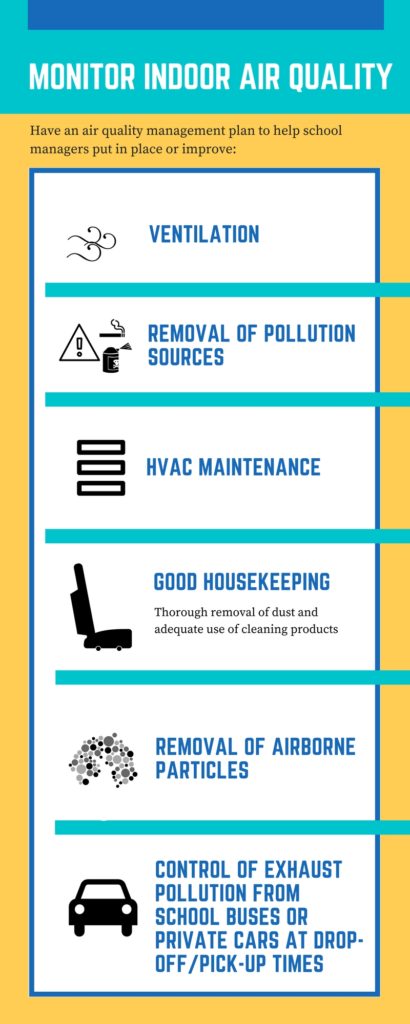Today, 235 million people across the world suffer from asthma. Indoor and outdoor pollution can trigger asthma attacks and make symptoms worse.
It is well documented that air pollution can trigger asthmatic reactions in people who are already diagnosed with asthma. The role of air pollution in people developing asthma is less understood. Nonetheless, research funded by the US Air Resources Board has shown that children living in communities with higher ozone levels and/or living closer to busy roads are more likely to develop asthma.
Asthma: a chronic disease of the lungs. The airways narrow, swell and produce more mucus. Which makes breathing difficult and trigger coughing, wheezing and shortness of breath.
Asthma is rarely fatal but causes sleepless nights, fatigue, reduced physical capacity as well as school and work absenteeism. The use of medication is important, but management of asthma triggers is essential to deal with this chronic disease and to enjoy a good quality of life and overcome the economic burden.
Indoor and outdoor air pollution can trigger asthma attacks and make symptoms worse because air pollution irritates the lungs and airways. Exposure to long-term air pollution in high concentrations can trigger asthma in both children and adults. A research study showed that people with moderate to severe asthma were 40% more likely to have an acute asthma episode on high pollution days. Moreover, research suggests that if your exposure happens during pregnancy your baby could be more likely to develop asthma because particulates can cross through the placenta to the developing baby. According to the US Center for Disease Control (CDC) asthma is primarily affected by ozone (smog) and particle pollution (haze, dust or smoke).
Ozone is a gas and contributes to ‘smog’, mostly present in urban areas where there are more cars and in the summer when sunlight increases. Ozone triggers asthma, it irritates the lungs and airways and reduces their function making it more difficult for a person to breathe deeply. It has been directly related to increased asthma attacks, increased asthma related emergencies and increased need for asthma treatment. Small particles are emitted into the air from industrial activity and energy production and can reduce lung function and increase asthma attacks. Moreover, 60% of people with asthma have allergic asthma, which means that allergens such as dust, pollen and pets can trigger inflammation of the airways and create an asthma attack. As a result of increased exposure to pollution, your airways can be more sensitive to allergens.
In Asia, it is estimated that less than 5% of adults suffer from asthma; and data about elderly asthma is not homogenous across the region, it ranges between 1.3 and 15.3% (5). A recent literature review on this subject showed that asthma was increasing with age in Asia, particularly in Korea, Japan, China, Hong Kong, Mongolia, Iran, India and Bangladesh.
Controlling asthma as well as the triggers that cause it to arise or get worse is important to lead a good quality life and also to reduce its economic burden. Asthma has direct costs in inhalers and medications and has indirect costs from the negative impact of productivity which can be as large as the direct costs. In addition, research showed asthma affects not only work absenteeism but also “presenteeism” (individual loss of function when at work). A study in the US in 2007 estimated that the total cost of asthma to society was USD 56 billion (USD3,259 per person). A separate research in Asia-Pacific estimated that indirect and direct costs ranged from USD184 in Vietnam to USD1,189 in Hong Kong.
HOT TIPS FOR ASTHMATICS
Simple tips to know if air pollution is triggering your asthma attacks:
- Keep a symptom diary and note daily activities and pollution levels. This will help you see patterns of symptoms linked to pollution levels.
- When pollution is high and even 24h after you might notice:
- Increased sensitivity to other asthma triggers,
- Symptoms are worse and harder to control,
- You are using your inhaler more.
Some tips on how to reduce asthma attacks triggered by pollution:
- Know when and where pollution is bad and plan outdoor activities when or where pollution levels are lower.
- Limit outside activities and outdoor physical exercise on high pollution days or in high pollution areas.
- If you do go out, do it earlier in the day before pollution kicks in and stick to back streets, with less traffic.
- Ensure your indoor air is clean and is not contaminated by outdoor air pollution. Avoid rush hours so that the quality of the air in your car can easily be controlled.
- Avoid the smoke from barbecues and bonfires.
- Note that the use of face masks may not make a difference to your asthma symptoms and can actually make breathing feel more difficult.
Sources:
AsthmaUK – Air Pollution and Asthma
Asthma and Allergy Foundation of America – Air Pollution
NIH – Epidemiology of Adult Asthma in Asi



